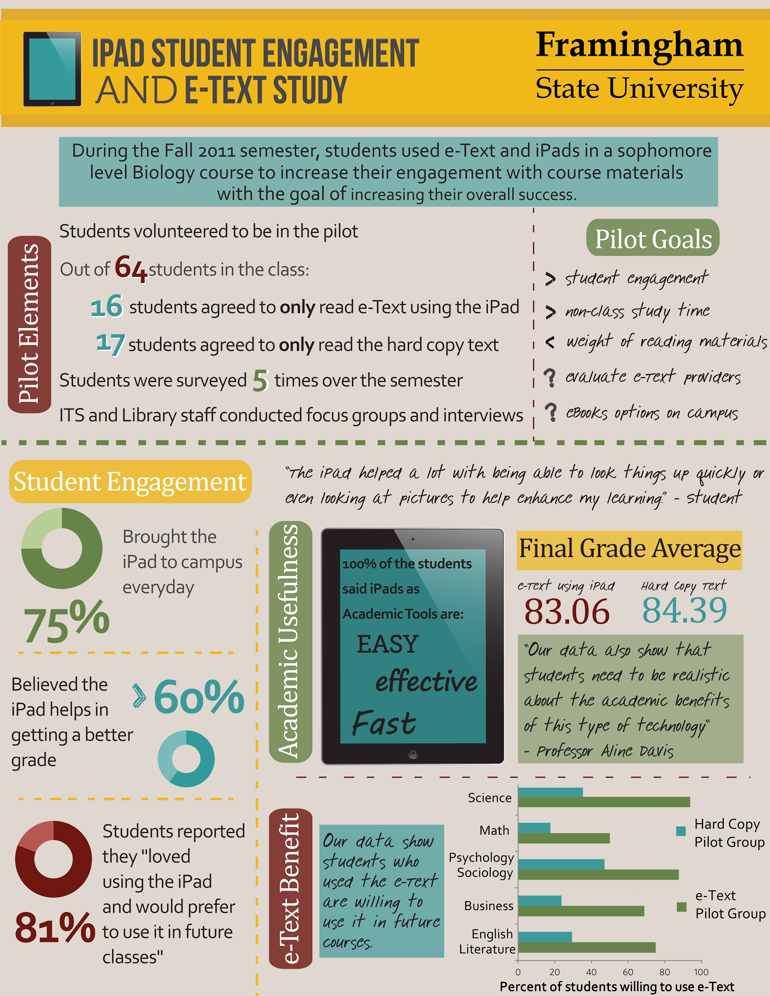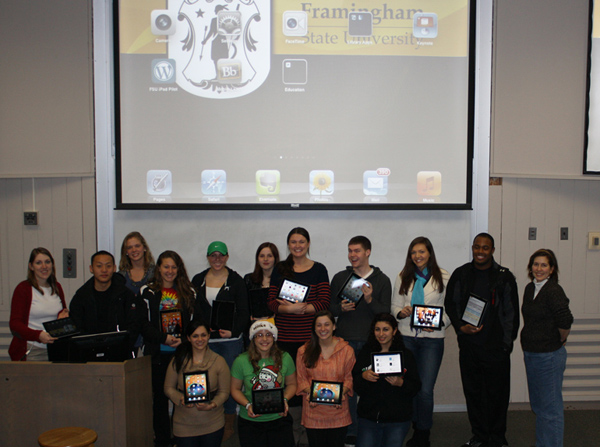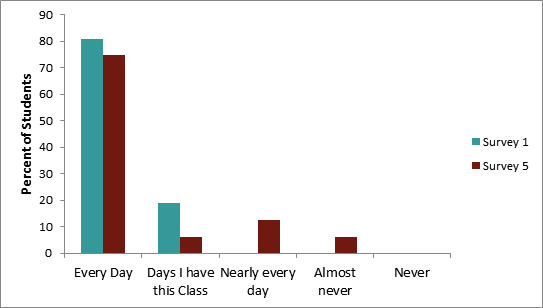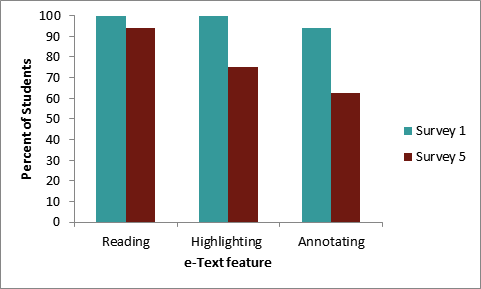Key Takeaways
- This single-class study sought to evaluate technology-enhanced student engagement by comparing the experiences of students using only an e-textbook with the experiences of those using only a standard textbook.
- Students were surveyed throughout the course, and more than 80 percent of the iPad users reported they "loved" using it and wanted to use it in future courses.
- Contrary to students' assumptions both before and after iPad use, however, students using the technology did not perform better than those using the standard textbook.

College students today prefer new ways of learning1 and feel energized by their ability to access many different tools, including the latest and greatest technologies. Although most of these technologies are designed for personal use, academic institutions can harness students' enthusiasm for technology by redirecting some of it into the classroom and the overall learning environment.
To this end, we evaluated how students used technology enhancements — including the Apple iPad2, audio lecture capture, and an e-textbook — in a sophomore-level biology course during the 2011 fall semester. We loaned tablets to approximately one-third of the students in a 64-student Human Anatomy and Physiology class; the students agreed to use the iPad with an electronic version of the required textbook and not access a hard copy of the text throughout the semester (figure 1). For comparison, another third of the class volunteered to use only the traditional hard copy of the text. The final third chose not to participate in the study. All of the student volunteers were surveyed multiple times over the course of the semester so that we could evaluate the use and usefulness of the tablets.

Figure 1. Class picture of the pilot study's iPad group
Our primary goal was to use technology to boost student engagement with course materials, with the overall goal of increasing student success. We determined increased engagement by:
- An increase in student study time outside of class
- Improved time management
- Increased overall academic performance
- A decrease in the number of students who failed or withdrew from the course
A study participant on using the iPad
In addition to this overall goal, we were also interested in determining if students appreciated the lower weight of class materials; evaluating the e-textbook's usefulness in a required science class; determining other ways in which the students used the technology; and examining the usefulness of the app associated with our learning management system.
Methodology
Two-thirds of the students in our large lecture class volunteered to participate in the study. One-third of the students volunteered to use the iPads to purchase and read the e-version of the textbook. These students were not to access or use the textbook's hard copy at any time during the semester. The second group used only the traditional hard copy of the textbook. Our initial plan was to have the final third of the class view the e-text using their laptops, but we did not have enough interest to include them (only two students volunteered), so the final third did not participate.
For assessment purposes, students took five surveys during the semester: one at the beginning of the semester and one after each exam. The surveys were a combination of multiple choice, Likert scale, and open response questions, modeled in part on those used by Notre Dame for their iPad pilot.2 In addition, several students participated in a focus group/interview near the end of the semester to reflect on their technology use during the course. The course instructor was aware of the students who were participating in the study, but did not have access to any results from the evaluations or reports until final course grades were submitted. No course assignments required students to use their tablets, nor was any form of extra credit given to any of the student volunteers. All students, regardless of group, signed an informed consent prior to participating in the study.
On the third day of class, we gave all of the tablet volunteers an Apple iPad 2 and a protective case. (In figure 2 a student is accessing lecture slides using the Blackboard Mobile app.) All went through a mandatory training session that offered a basic introduction to the iPad, how to download and purchase apps, and how to access the e-text and navigate in the Pearson App. All iPad students were required to purchase an electronic copy of the textbook for viewing on the iPad. No other purchased materials or applications were provided to the students.

Figure 2. An FSU sophomore who participated in the pilot study's iPad group
An audio recording of each day's lecture was posted on the LMS, usually within 48 hours of recording. All students enrolled in the course had access to the recording, regardless of whether they were participating in the study. There was no video component to the lecture recording, and no written transcript of the recordings was provided. All recordings were in MP3 format and uploaded to the LMS directly.
Results
Not surprisingly, the overall assessment of the iPads as an academic tool were favorable. At the end of the semester, all of the e-text students surveyed rated the iPad as very easy/easy, very effective/effective, very fast/fast, and very useful/useful. On the final survey, 81.3 percent of students strongly agreed or agreed that they "loved using the iPad and would prefer to use it in future classes." Similarly, 87.5 percent of the students strongly agreed or agreed that their book bags were lighter.
At the beginning of the semester, 6 percent of the students surveyed ranked their iPad skill level as either very extensive or quite extensive compared with 47.5 percent of the students at the end of the semester. All of the students agreed that the iPad was easy to use and that they had the knowledge necessary to use the iPad. More than 93 percent of the students strongly agreed or agreed with the statement, "If I had an iPad, independent of this course, I would use it in this course," compared with only approximately 69 percent prior to using the iPads for the semester. All students who participated in the pilot's tablet-portion strongly agreed or agreed that they would like to use an iPad in future classes.
In the initial survey, students were asked to estimate the amount of time that they would bring their iPads to campus, and if they would use them for course work (see figure 3). In Survey 1, which was taken the day the students received their iPads, 81 percent of the students said they anticipated bringing their iPads to school every day, including days that they did not have Human Anatomy and Physiology. The remainder of the students (19 percent) said they would bring their iPads every day that they had class, but not on other days. Survey 5, which was taken just before the final exam, indicated that most students (75 percent) actually did bring their iPads to campus every day, and 6.3 percent brought their iPad to campus every day they had Human Anatomy and Physiology. Unlike their predictions, however, 12.5 percent of the students brought their iPad almost every day, while 6.3 almost never brought the tablet to campus. Overall, it appears that most students had no issues with transporting the device back and forth to campus, even though there were no specific assignments using the tablet in class.

Figure 3. How often students brought iPads to campus during the semester
However, when it comes to specific tasks involving the iPad, not all the results were as favorable. For example, prior to using the iPads, 62.2 percent of the students said they thought that using the iPad would help with their time management, but at the end of the semester, only about 56 percent reported this as a favorable outcome. About 81 percent of the students agreed or strongly agreed that if it were easier to print from the tablet, they would do it more often. One student in the study reported detrimental health effects, such as eyestrain.
We gave students very little guidance and instruction about useful apps that they might load and use during the semester. Not unexpectedly, the students utilized several educational apps on their iPads during the semester. On the final survey, 100 percent of the students noted being very satisfied or satisfied with the applications used to access e-mail and the LMS on campus (Blackboard via the Blackboard Mobile Learn App). About 88 percent of the students ranked other learning apps in the very satisfied/satisfied category.
Our data also shows that students need to be realistic about the benefits of this type of technology in their education. A comparison of survey data from surveys 1 and 5 indicates that students felt that using the iPad would increase their chances of getting a good grade; this belief was strengthened during the semester (see Figure 4). Results show that more students answered strongly agree or agree after using the iPad for the semester. However, the final average grades for the semester were: 83.06 (e-text students), 84.39 (hard-copy students) and 83.34 for students who did not participate in the study. Our data do not support the conclusion that tablet use alone can increase academic performance. (Note that this comparison assumes that average grades for students would be the same across groups if the study had not been conducted.)

Figure 4. Percent of students who indicated that iPad use increases the odds of getting a good grade
According to the surveys, 81 percent of the iPad students and 59 percent of the hard-copy text students listened to the audio capture of the lectures. However, students made several suggestions about features that would make the lecture recordings more useful and less time consuming, including available transcripts, iTunes compatibility, and incremental markers on the time recordings.
One of our main goals in this pilot study was to assess the value of e-texts compared with traditional hard-copy textbooks. In the initial survey (taken on the first day that students received their iPads), 100 percent of students anticipated being very satisfied or satisfied with reading, annotating, and highlighting the e-text (see figure 5). Although 94 percent still said they were very satisfied or satisfied with reading the e-text on Survey 5 at the semester's end, only 75 percent felt the same about highlighting and only about 63 percent were very satisfied or satisfied with the annotating features. Interestingly, at the semester's end 19 percent of students said they had never used either annotation or highlighting when reading the e-text. Because some of these results might be specific to the semester's textbook and applications, we cannot draw broad conclusions about these e-text features.

Figure 5. Percent of students who reported being very satisfied or satisfied with e-text features
A junior student who participated in the iPad study talks about using the iPad.
Interestingly, at the semester's end, 44 percent of the students who used the iPad either did not agree or disagreed with the statement that they would prefer to use traditional textbooks in the future. Only 12.5 percent of the iPad students strongly agreed with the statement. We also asked students about their future preferences for using e-texts in classes based on discipline (see Figure 6). Overall, the students who used the e-text on the tablet were much more willing to use an e-text in all suggested disciplines, with science, psychology/sociology, and English/literature courses receiving the highest levels of interest. For students who used the hard copy, only 47 percent were very willing or willing to use an e-text in a future class, and then only in a psychology/sociology class. Students in both groups were least willing to use an e-text in a math class. Again, however, the tablet group was much more open to using an e-text in math courses (50 percent) than the hard-copy group (18 percent).

Figure 6. Interest in future e-text use by discipline
In addition to the multiple-choice questions, we let students provide feedback via open response questions on the surveys, as well as in individual interviews and a focus group meeting. We received several valuable comments about what students liked and particularly disliked regarding both the tablets and how the pilot study was run. Many students said they would prefer to have an external keyboard to make their interactions with the tablet more productive. Also, several said that their preferred venue for interacting with the textbook depended on their setting. When they were studying in their room, they preferred the hard-copy text, but when coming to class or reading in bed or anywhere other than their primary residence, they preferred the tablet's portability and easy access. Many students said it was going to be difficult to give up their iPads, because they had enjoyed using them and had integrated them into their routines.

Figure 7. FSU students engaging with the iPads for group work
Conclusions
The tablet data our study gathered suggest that iPads can be used not only as e-readers, but as technological learning-enhancement tools, even when students are given minimal instruction and no additional incentive/reward for use. Our students proved willing and able to engage with the course materials in a nontraditional fashion, and the iPads allow for fast, portable interactions with the materials, which can lead to an overall increase in study time outside of class. Many of these results are similar to those of other iPad studies.2
The iPad tablet is currently the top seller in the market, with over 13 million units sold in the first quarter of 2012 alone.3 Several campuses and faculty have been studying the usefulness of iPads and other technology enhancements with their students.4 Our study differs from previous studies in two important ways: the students in the iPad group self-selected, and both study groups attended the same lecture. All of the students using the iPads were volunteers, meaning that those who were in the e-text group understood their situation in terms of use of resources, and could freely make a choice. We thus assume that all or most of our e-text volunteers had at least minimal interest in the technology going into the project, which could contribute to increased enthusiasm and integration of the technology into the student's daily activities. However, no assessment was made of this initial interest. Also, many other studies have distributed iPads to entire classes,5 while our study provided them to only about one-third of the class. An additional third of students in the same class used only the hard-copy textbook and also participated in the surveys. In contrast, previous iPad studies have used other sections of the same course with the same instructor as a control group. However, the fact that our students were all enrolled in the same lecture section insured that all students had the exact same classroom experience.
We implemented our study design to determine how useful the technological enhancements were in a more traditional, lecture-style course. We did not redesign the course to suit the iPads; we wanted to see how the students would integrate them into their current educational process.
A senior discusses engagement with the iPad during the pilot study.
As in other studies, our results suggest that iPads are quick, useful, portable, and easy to interact with, and college students seem to be very interested in using them. These conclusions are further supported by the EDUCAUSE study of 2012.6 When it comes to e-text reading, however, the textbook interface might not live up to the student's expectations, which might become an issue. We are optimistic that this opinion might change as e-texts and their apps become more interactive in the future. Further, while tablet-based textbooks can be effective, many current students seem to be reluctant to use them in their classes in place of a hard-copy text. This use might also be subject-specific, with students being more likely to use an e-text in a social science course, and least willing in a math course. However, our data also suggest that students who are exposed to e-texts and use them in classes might be more willing to use an e-text in the future.
- Maureen E. Wilson, "Teaching, Learning and Millennial Students," New Direction for Student Services, vol. 2004, no. 106, 2004, pp. 59–71.
- Corey M. Angst and Emily Malinowski, Findings from eReader Project, Phase 1: Use of iPads in MGT40700, Project Management, University of Notre Dame Working Paper Series, Mendoza College of Business, University of Notre Dame, 2010, pp. 1–17; Trina Marmarelli and Martin Ringle, The Reed College iPad Study, The Reed Institute, 2011; and Ian J. Shepard and Brent Reeves, "iPad or iFad? Realities of a Paperless Classroom," ACU Connected, 2011, Abilene Christian University.
- Hidetoshi Himuro and Richard Shim, Quarterly Mobile PC Shipment and Forecast Report, NPD DisplaySearch Q2'12, 2012.
- Ben Wieder, "iPads Could Hinder Teaching, Professors Say," Chronicle of Higher Education, March 13, 2011; Jeffrey R. Young, "A Test for the iPad: Will It Bring the Internet to the Beanbag Chair?" Chronicle of Higher Education, April 7, 2010; and Elizabeth Woyke, "Pros and Cons of iPads in the Classroom," Forbes.com, January 21, 2011.
- Angst and Malinowski, Findings from eReader Project, Phase 1; and Marmarelli and Ringle, The Reed College iPad Study.
- Eden Dahlstrom, ECAR Study of Undergraduate Students and Information Technology, EDUCAUSE Center for Applied Research, 2012.
© 2012 Aline M. Davis, Clair Waterbury, and Robin S. Robinson. The text of this EDUCAUSE Review Online article is licensed under the Creative Commons Attribution-Noncommercial-No derivative works 3.0 license.
